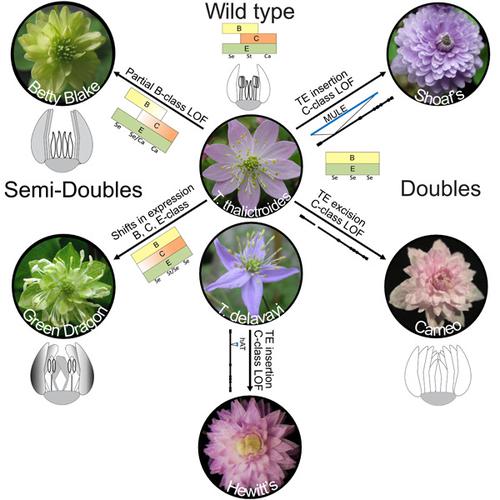当前位置:
X-MOL 学术
›
Evol. Dev.
›
论文详情
Our official English website, www.x-mol.net, welcomes your feedback! (Note: you will need to create a separate account there.)
Spontaneous homeotic mutants and genetic control of floral organ identity in a ranunculid
Evolution and Development ( IF 2.9 ) Pub Date : 2020-11-12 , DOI: 10.1111/ede.12357 Jesús Martínez-Gómez 1 , Kelsey D Galimba 1 , Erin Y Coté 1 , Alessandra M Sullivan 1 , Verónica S Di Stilio 1
Evolution and Development ( IF 2.9 ) Pub Date : 2020-11-12 , DOI: 10.1111/ede.12357 Jesús Martínez-Gómez 1 , Kelsey D Galimba 1 , Erin Y Coté 1 , Alessandra M Sullivan 1 , Verónica S Di Stilio 1
Affiliation

|
The regulation of floral organ identity was investigated using a forward genetic approach in five floral homeotic mutants of Thalictrum, a noncore eudicot. We hypothesized that these mutants carry defects in the floral patterning genes. Mutant characterization comprised comparative floral morphology and organ identity gene expression at early and late developmental stages, followed by sequence analysis of coding and intronic regions to identify transcription factor binding sites and protein–protein interaction (PPI) motifs. Mutants exhibited altered expression of floral MADS‐box genes, which further informed the function of paralogs arising from gene duplications not found in reference model systems. The ensuing modified BCE models for the mutants supported instances of neofunctionalization (e.g., B‐class genes expressed ectopically in sepals), partial redundancy (E‐class), or subfunctionalization (C‐class) of paralogs. A lack of deleterious mutations in the coding regions of candidate floral MADS‐box genes suggested that cis‐regulatory or trans‐acting mutations are at play. Consistent with this hypothesis, double‐flower mutants had transposon insertions or showed signs of transposon activity in the regulatory intron of AGAMOUS (AG) orthologs. Single amino acid substitutions were also found, yet they did not fall on any of the identified DNA binding or PPI motifs. In conclusion, we present evidence suggesting that transposon activity and regulatory mutations in floral homeotic genes likely underlie the striking phenotypes of these Thalictrum floral homeotic mutants.
中文翻译:

毛茛科植物的自发同源突变体和花器官特性的遗传控制
使用正向遗传方法在Thalictrum的五种花同源突变体中研究了花器官特性的调节,非核心真双子叶植物。我们假设这些突变体在花卉图案基因中携带缺陷。突变体表征包括早期和晚期发育阶段的比较花形态和器官同一性基因表达,然后对编码和内含子区域进行序列分析,以确定转录因子结合位点和蛋白质-蛋白质相互作用 (PPI) 基序。突变体表现出花 MADS-box 基因的表达改变,这进一步说明了由参考模型系统中未发现的基因重复引起的旁系同源物的功能。随后修改的突变体 BCE 模型支持旁系同源物的新功能化(例如,B 类基因在萼片中异位表达)、部分冗余(E 类)或亚功能化(C 类)的实例。顺式调节或反式作用突变在起作用。与该假设一致,双花突变体在AGAMOUS ( AG ) 直系同源物的调节内含子中具有转座子插入或显示转座子活性迹象。还发现了单个氨基酸取代,但它们不属于任何已鉴定的 DNA 结合或 PPI 基序。总之,我们提供的证据表明,花同源基因中的转座子活性和调控突变可能是这些Thalictrum花同源突变体的显着表型的基础。
更新日期:2020-11-12
中文翻译:

毛茛科植物的自发同源突变体和花器官特性的遗传控制
使用正向遗传方法在Thalictrum的五种花同源突变体中研究了花器官特性的调节,非核心真双子叶植物。我们假设这些突变体在花卉图案基因中携带缺陷。突变体表征包括早期和晚期发育阶段的比较花形态和器官同一性基因表达,然后对编码和内含子区域进行序列分析,以确定转录因子结合位点和蛋白质-蛋白质相互作用 (PPI) 基序。突变体表现出花 MADS-box 基因的表达改变,这进一步说明了由参考模型系统中未发现的基因重复引起的旁系同源物的功能。随后修改的突变体 BCE 模型支持旁系同源物的新功能化(例如,B 类基因在萼片中异位表达)、部分冗余(E 类)或亚功能化(C 类)的实例。顺式调节或反式作用突变在起作用。与该假设一致,双花突变体在AGAMOUS ( AG ) 直系同源物的调节内含子中具有转座子插入或显示转座子活性迹象。还发现了单个氨基酸取代,但它们不属于任何已鉴定的 DNA 结合或 PPI 基序。总之,我们提供的证据表明,花同源基因中的转座子活性和调控突变可能是这些Thalictrum花同源突变体的显着表型的基础。


























 京公网安备 11010802027423号
京公网安备 11010802027423号